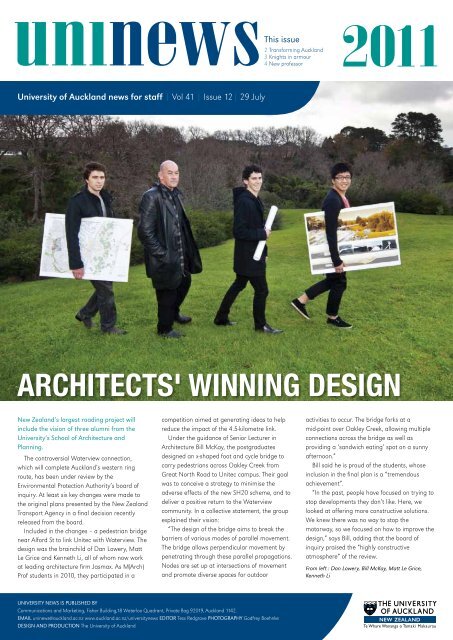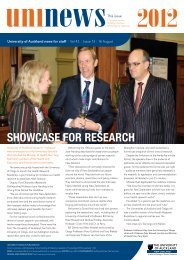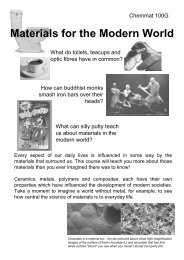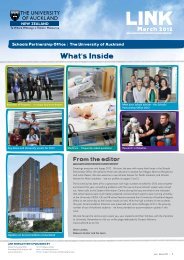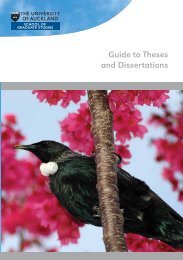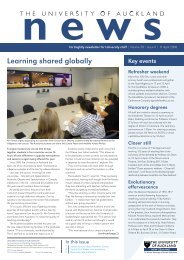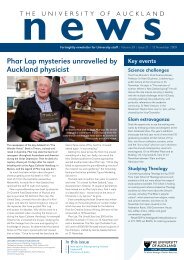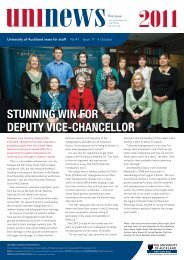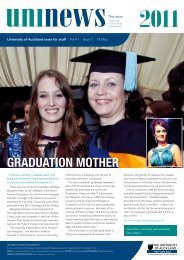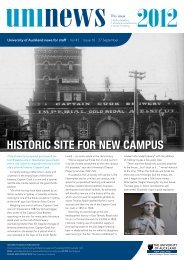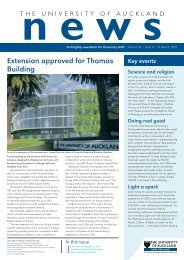Architects' winning design - The University of Auckland
Architects' winning design - The University of Auckland
Architects' winning design - The University of Auckland
You also want an ePaper? Increase the reach of your titles
YUMPU automatically turns print PDFs into web optimized ePapers that Google loves.
<strong>University</strong> <strong>of</strong> <strong>Auckland</strong> news for staff | Vol 41 | Issue 12| 29 July<br />
UniversiTy news is pUblished by<br />
Communications and Marketing, Fisher Building,18 Waterloo Quadrant, Private Bag 92019, <strong>Auckland</strong> 1142.<br />
eMAil uninews@auckland.ac.nz www.auckland.ac.nz/universitynews ediTor Tess Redgrave phoTogrAphy Godfrey Boehnke<br />
<strong>design</strong> And prodUCTion <strong>The</strong> <strong>University</strong> <strong>of</strong> <strong>Auckland</strong><br />
This issue<br />
2 Transforming <strong>Auckland</strong><br />
3 Knights in armour<br />
4 New pr<strong>of</strong>essor<br />
<strong>Architects'</strong> <strong>winning</strong> <strong>design</strong><br />
new Zealand’s largest roading project will<br />
include the vision <strong>of</strong> three alumni from the<br />
<strong>University</strong>’s school <strong>of</strong> Architecture and<br />
planning.<br />
<strong>The</strong> controversial Waterview connection,<br />
which will complete <strong>Auckland</strong>’s western ring<br />
route, has been under review by the<br />
Environmental Protection Authority’s board <strong>of</strong><br />
inquiry. At least six key changes were made to<br />
the original plans presented by the New Zealand<br />
Transport Agency in a final decision recently<br />
released from the board.<br />
Included in the changes – a pedestrian bridge<br />
near Alford St to link Unitec with Waterview. <strong>The</strong><br />
<strong>design</strong> was the brainchild <strong>of</strong> Dan Lowery, Matt<br />
Le Grice and Kenneth Li, all <strong>of</strong> whom now work<br />
at leading architecture firm Jasmax. As M(Arch)<br />
Pr<strong>of</strong> students in 2010, they participated in a<br />
competition aimed at generating ideas to help<br />
reduce the impact <strong>of</strong> the 4.5-kilometre link.<br />
Under the guidance <strong>of</strong> Senior Lecturer in<br />
Architecture Bill McKay, the postgraduates<br />
<strong>design</strong>ed an x-shaped foot and cycle bridge to<br />
carry pedestrians across Oakley Creek from<br />
Great North Road to Unitec campus. <strong>The</strong>ir goal<br />
was to conceive a strategy to minimise the<br />
adverse effects <strong>of</strong> the new SH20 scheme, and to<br />
deliver a positive return to the Waterview<br />
community. In a collective statement, the group<br />
explained their vision:<br />
“<strong>The</strong> <strong>design</strong> <strong>of</strong> the bridge aims to break the<br />
barriers <strong>of</strong> various modes <strong>of</strong> parallel movement.<br />
<strong>The</strong> bridge allows perpendicular movement by<br />
penetrating through these parallel propagations.<br />
Nodes are set up at intersections <strong>of</strong> movement<br />
and promote diverse spaces for outdoor<br />
activities to occur. <strong>The</strong> bridge forks at a<br />
mid-point over Oakley Creek, allowing multiple<br />
connections across the bridge as well as<br />
providing a ‘sandwich eating’ spot on a sunny<br />
afternoon.”<br />
Bill said he is proud <strong>of</strong> the students, whose<br />
inclusion in the final plan is a “tremendous<br />
achievement”.<br />
“In the past, people have focused on trying to<br />
stop developments they don’t like. Here, we<br />
looked at <strong>of</strong>fering more constructive solutions.<br />
We knew there was no way to stop the<br />
motorway, so we focused on how to improve the<br />
<strong>design</strong>,” says Bill, adding that the board <strong>of</strong><br />
inquiry praised the “highly constructive<br />
atmosphere” <strong>of</strong> the review.<br />
From left : Dan Lowery, Bill McKay, Matt Le Grice,<br />
Kenneth Li
From the Vice-chancellor<br />
leading the way<br />
<strong>The</strong> recent announcement <strong>of</strong> a $4 million gift<br />
to the <strong>University</strong> by Engineering alumnus Kim<br />
Goldwater and his wife Jeanette in association<br />
with the establishment <strong>of</strong> their Waiheke Island<br />
winery as the new centre for our Wine Science<br />
programme highlights once again the<br />
tremendous power <strong>of</strong> philanthropy.<br />
<strong>The</strong> history <strong>of</strong> philanthropy is as long and<br />
distinguished as the history <strong>of</strong> our <strong>University</strong>.<br />
In 1884, just one year after the <strong>University</strong> was<br />
founded, Thomas B Gillies, Justice <strong>of</strong> the<br />
Supreme Court, endowed a Science<br />
Scholarship that has now been awarded for<br />
126 years. <strong>The</strong> recipient in 1970 would<br />
eventually become Sir Vaughan Jones, New<br />
Zealand’s most eminent mathematician and<br />
1990 winner <strong>of</strong> the Fields Medal, mathematics’<br />
equivalent <strong>of</strong> the Nobel Prize. However, for<br />
much <strong>of</strong> that period, our approach to<br />
generating philanthropic support for the<br />
<strong>University</strong> has been somewhat haphazard.<br />
<strong>The</strong> infrastructure we have more recently<br />
put in place through the External Relations and<br />
Development Office and the faculties has<br />
undoubtedly given many donors the confidence<br />
to invest in the <strong>University</strong>, knowing that their<br />
gifts will be stewarded wisely and devoted only<br />
to the purposes which they have specified. This<br />
confidence, and our active engagement with a<br />
wide range <strong>of</strong> donors, has led to outstanding<br />
success in our Leading the Way philanthropic<br />
campaign. As a result, our original campaign<br />
target <strong>of</strong> $100million to be raised over the life<br />
<strong>of</strong> the current Strategic Plan (2006-2012) has<br />
been well and truly surpassed.<br />
<strong>The</strong> current total <strong>of</strong> $158 million comprises<br />
about $120 million in “current use” funds<br />
(those that will be used for a specific project<br />
over the next few years) and the balance in<br />
endowment funds (for which the capital value<br />
will be maintained and interest income used).<br />
<strong>The</strong> endowment funds will be expected to<br />
generate on average $2 million each year in<br />
perpetuity. With its focus on excellent people,<br />
the Campaign is helping us to support<br />
outstanding students and staff through<br />
scholarships, fellowships, research positions<br />
and even eight funded chairs. Given that the<br />
quality <strong>of</strong> a university is ultimately determined<br />
by the quality <strong>of</strong> its people, this support by a<br />
wide range <strong>of</strong> donors will be critical to our<br />
future as a leading international university.<br />
2 29 July 2011<br />
transforming <strong>Auckland</strong><br />
what steps can we take to make <strong>Auckland</strong> a<br />
more sustainable city? This is the challenge for<br />
<strong>University</strong> <strong>of</strong> <strong>Auckland</strong> researchers posed by<br />
the <strong>The</strong>matic research initiative (Tri) which<br />
aims to increase cross-faculty collaboration<br />
and inter-disciplinary research on the theme:<br />
“Transforming <strong>Auckland</strong>: institutional,<br />
technological and cultural innovations for<br />
sustainable cities”.<br />
This year’s funding round has resulted in five<br />
new projects that will tackle topics ranging from<br />
water, solar power energy, housing, transport,<br />
and green infrastructure. <strong>The</strong>y were launched at<br />
a special celebration on 1 July attended by the<br />
TRI Champion (Dean <strong>of</strong> the National Institute <strong>of</strong><br />
Creative Arts and Industries, Pr<strong>of</strong>essor Jenny<br />
Dixon), <strong>Auckland</strong> Council Research Unit<br />
managers (Grant Barnes and Eva McLaren) and<br />
members <strong>of</strong> the TRI Steering Committee. <strong>The</strong> five<br />
research teams involve 27 researchers from six<br />
faculties at the <strong>University</strong>, including new<br />
research partnerships with Massey <strong>University</strong><br />
and an external consultant.<br />
Not surprisingly, the TRI research is <strong>of</strong> great<br />
interest to the <strong>Auckland</strong> Council, which this year<br />
contributed financial and personnel support. In a<br />
welcoming speech, Pr<strong>of</strong>essor Errol Haarh<strong>of</strong>f,<br />
Chair <strong>of</strong> the Steering Committee, acknowledged<br />
the Council’s support and suggested the<br />
graduate survey<br />
<strong>The</strong> graduate longitudinal study new Zealand<br />
(glsnZ) — a large-scale survey <strong>design</strong>ed to<br />
determine the ongoing impact <strong>of</strong> a university<br />
education on new Zealand graduates’ lives<br />
— is being launched at <strong>The</strong> <strong>University</strong> <strong>of</strong><br />
<strong>Auckland</strong> this coming week.<br />
Some 3894 <strong>of</strong> our students are being<br />
approached to take part.<br />
Commissioned by Universities New Zealand-<br />
Te Pōkai Tara and with funding from the<br />
Government, the study involves surveying<br />
14,300 final-year students across eight New<br />
Zealand universities about their lifestyles,<br />
employment, projected career development, and<br />
interdisciplinary focus <strong>of</strong> the TRI research will<br />
enable a broader, more integrated approach to<br />
the task <strong>of</strong> improving <strong>Auckland</strong>’s sustainability.<br />
<strong>The</strong> five projects funded are: “A critical<br />
evaluation <strong>of</strong> housing intensification strategies”,<br />
which will use <strong>Auckland</strong> case studies to examine<br />
potential market and consumer resistance. An<br />
innovative arts-science collaboration between<br />
researchers in NICAI, Science and Education to<br />
investigate “Water in the sustainable city” aims<br />
to devise a series <strong>of</strong> urban installation and<br />
performance works “that will bring to light the<br />
material, technical, social, cultural, spiritual and<br />
economic dimensions <strong>of</strong> water in <strong>Auckland</strong> City”.<br />
<strong>Auckland</strong>’s “Solar renewable energy potential”<br />
brings together researchers from NICAI,<br />
Engineering and Business to look at the potential<br />
for photovoltaic energy from <strong>Auckland</strong>’s built<br />
environment. Other research underway is<br />
looking at “Transforming <strong>Auckland</strong>’s<br />
transportation system”, which will develop a tool<br />
allowing people and policymakers to assess the<br />
impacts <strong>of</strong> their transport mode choice. <strong>The</strong><br />
“Greening <strong>of</strong> <strong>Auckland</strong>” looks at the potential<br />
benefits <strong>of</strong> “green infrastructure” aimed at<br />
managing stormwater and reducing energy use<br />
and carbon emissions.<br />
www.transforming.auckland.ac.nz<br />
their health and well-being. <strong>Auckland</strong> is one <strong>of</strong><br />
the first universities to launch the study, with<br />
other universities following in coming weeks.<br />
<strong>The</strong> survey targets final-year undergraduate<br />
and postgraduate students and those who<br />
participate in this initial survey will be<br />
approached again for follow-up surveys in two,<br />
five and ten years’ time.<br />
While similar studies have been undertaken<br />
overseas, the Graduate Longitudinal Survey New<br />
Zealand will be the most comprehensive.<br />
Results <strong>of</strong> the initial baseline survey will be<br />
released in February next year.
Knights in heavy armour<br />
suits <strong>of</strong> armour might have made medieval<br />
soldiers feel safe, but modern scientists have<br />
found they were so heavy and constricting they<br />
were likely to have limited performance and<br />
even influenced the outcome <strong>of</strong> battles.<br />
<strong>The</strong> research, by scientists at <strong>The</strong> <strong>University</strong> <strong>of</strong><br />
<strong>Auckland</strong>, <strong>University</strong> <strong>of</strong> Leeds, and <strong>University</strong> <strong>of</strong><br />
Milan, has been published in the Proceedings <strong>of</strong><br />
the Royal Society <strong>of</strong> London, Biological Sciences.<br />
Architect's lecture<br />
Ian Athfield features in the Fast Forward series.<br />
Established in 1968, Athfield Architects began<br />
producing experimental and <strong>of</strong>ten provocative<br />
residential projects, including landmark projects<br />
in the history <strong>of</strong> New Zealand housing such as<br />
the Buck and Custance Houses. In the 1980s the<br />
practice took on a wider variety <strong>of</strong> community<br />
and commercial buildings, and in the last two<br />
decades had produced significant and <strong>of</strong>ten<br />
audacious public projects, such as Wellington's<br />
Public Library and Civic Square, Jade Stadium in<br />
Christchurch, and the Palmerston North Public<br />
Library. In 1997 <strong>The</strong> <strong>University</strong> <strong>of</strong> <strong>Auckland</strong><br />
named Ian Athfield a Distinguished Alumnus,<br />
and in 1996 he was made Companion <strong>of</strong> the<br />
New Zealand Order <strong>of</strong> Merit.<br />
Engineering Lecture <strong>The</strong>atre 439, 20 Symonds<br />
Street, 3 August, 6.30pm-7.30pm<br />
www.creative.auckland.ac.nz/fastforward<br />
“<strong>The</strong> steel plate armour worn by<br />
soldiers in medieval Europe weighed 30<br />
to 50 kg, and there was a real trade-<strong>of</strong>f<br />
between increased protection and<br />
reduced mobility,” says Dr Federico<br />
Formenti from the Department <strong>of</strong> Sport<br />
and Exercise Science.<br />
“Our research showed that wearing<br />
a suit <strong>of</strong> armour doubled the amount <strong>of</strong><br />
energy that a soldier used to walk or<br />
run, and substantially reduced<br />
his speed.”<br />
For instance, a 38-year-old man who<br />
could normally walk at up to<br />
10 km/h would have been limited to<br />
6 km/h in armour, while an older<br />
man <strong>of</strong> 55 years could only manage<br />
5 km/h.<br />
<strong>The</strong> effect was greater than could be<br />
accounted for by the extra weight<br />
alone, and reflected the distribution <strong>of</strong><br />
armour around the body.<br />
“Carrying a load <strong>of</strong> 30kg spread<br />
around the body requires more energy<br />
than carrying the same load in a<br />
backpack,” explains Dr Graham Askew from<br />
Leeds <strong>University</strong>. “This is because, in a suit <strong>of</strong><br />
armour, the limbs are loaded with weight, which<br />
means it takes more effort to swing them with<br />
each stride. If you’re wearing a backpack, the<br />
weight is all in one place and swinging the limbs<br />
is easier.”<br />
“In nature the fastest-running animals, such as<br />
cheetahs or ostriches, have relatively light and<br />
Buildings 403 and 404<br />
This is your chance to showcase your work and<br />
potentially have it incorporated in the rebuild <strong>of</strong><br />
Engineering’s buildings 403 and 404. As part <strong>of</strong><br />
the Infrastructure and Environment research<br />
theme, we are holding a workshop for staff to<br />
present their ideas on how the new buildings<br />
might function.<br />
Come along and share your views on how the<br />
new buildings might operate or look, and how<br />
your research could be demonstrated as an<br />
integral part <strong>of</strong> the new buildings. Each speaker<br />
will have a five-minute opportunity to showcase<br />
their research. Property Services, the <strong>design</strong><br />
team and Jasmax Architects will be attending<br />
this workshop.<br />
Date: Tuesday 2 August, 9.30am to 12 noon,<br />
Venue: Building 401, room 511<br />
RSVP to Chris Ford c.ford@auckland.ac.nz<br />
thin limbs,” says Dr Formenti. “Weighing down<br />
the limbs is clearly unhelpful in situations where<br />
quick movement is required.”<br />
As if that wasn’t enough, suits <strong>of</strong> armour also<br />
appear to have constricted breathing. Armour<br />
limits the amount <strong>of</strong> air that can be taken in at<br />
each breath and increases the amount <strong>of</strong><br />
energy required to breathe.<br />
“Being wrapped up in a tight shell <strong>of</strong> thick<br />
steel makes one feel invincible but also unable<br />
to take a deep breath,” says Dr Formenti. “You<br />
feel breathless as soon as you move around in<br />
medieval armour, and this would most likely<br />
limit a soldier’s ability to fight.”<br />
<strong>The</strong> research was undertaken with a team <strong>of</strong><br />
highly skilled volunteers accustomed to wearing<br />
armour for shows at the Royal Armouries<br />
Museum in Leeds. <strong>The</strong> amount <strong>of</strong> energy that<br />
the volunteers expended, while walking or<br />
running in exact replicas <strong>of</strong> four types <strong>of</strong><br />
European armour, was calculated by measuring<br />
the amount <strong>of</strong> oxygen they used.<br />
<strong>The</strong> results have implications for<br />
understanding the outcomes <strong>of</strong> historic battles.<br />
For instance the findings lend weight to the idea<br />
that exhaustion contributed to the defeat <strong>of</strong><br />
heavily-armoured French soldiers against their<br />
lighter English enemy on the muddy battlefield<br />
at Agincourt (1415) and following the long<br />
march to the Battle <strong>of</strong> Crécy (1346).<br />
Photo: A volunteer in replica armour has his<br />
oxygen use measured while walking on a treadmill.<br />
Photograph by Dr Graham Askew, <strong>University</strong> <strong>of</strong> Leeds.<br />
highlighted events<br />
call for contributions<br />
Contributions to present at CAD’s 11th Annual<br />
Teaching and Learning Showcase are now<br />
being received.<br />
<strong>The</strong> showcase aims to celebrate the<br />
achievements <strong>of</strong> some <strong>of</strong> the <strong>University</strong>’s<br />
outstanding teachers. This year’s showcase will<br />
take on the theme <strong>of</strong> Active Learning, and will<br />
take place at the Engineering Building on<br />
Tuesday 25 and Wednesday 26 October.<br />
If you would like to present at this event, see the<br />
proposal guidelines (found on the right-hand side<br />
<strong>of</strong> CAD’s home page in the news and event<br />
section) at www.cad.auckland.ac.nz/index.<br />
php?p=news_detail&item=263.<br />
Proposals are due by Monday 22 August.<br />
An invitation to attend the Teaching and<br />
Learning Showcase and registration will be<br />
issued once programme details are finalised<br />
Contact Dr Barbara Kensington-Miller at b.<br />
kensington-miller@auckland.ac.nz<br />
<strong>The</strong> <strong>University</strong> <strong>of</strong> <strong>Auckland</strong> News 3
new pr<strong>of</strong>essor<br />
“social justice gets me to work in the<br />
mornings. it’s about our most vulnerable<br />
student groups – Māori, pasifika and low<br />
income students – not doing as well as they<br />
should be at school,” says pr<strong>of</strong>essor liz<br />
McKinley.<br />
Liz, the director <strong>of</strong> the Starpath Project, is the<br />
Faculty <strong>of</strong> Education’s newest pr<strong>of</strong>essor.<br />
<strong>The</strong> former secondary school teacher is a role<br />
model in more ways than one. She was the first<br />
in her family to go to university, she was in<br />
charge <strong>of</strong> a secondary school science<br />
department when it was a rarity for a woman,<br />
let alone a Māori woman, and she now<br />
spearheads a research unit which is making a<br />
difference for Māori and Pacific Island students<br />
and students from low income families.<br />
Liz, <strong>of</strong> Ngāti Kahungunu ki Wairarapa and<br />
Ngāi Tahu descent, grew up in the Wairarapa.<br />
She went to Kuranui College before earning an<br />
undergraduate science degree at the <strong>University</strong><br />
<strong>of</strong> Otago and she completed both a masters<br />
degree and PhD at the <strong>University</strong> <strong>of</strong> Waikato<br />
while teaching full-time.<br />
“My parents set the bar quite high in terms <strong>of</strong><br />
education. <strong>The</strong>y always had aspirations for us<br />
regarding secondary education. Your weren’t<br />
Tickets are on sale now for the Mid-winter<br />
Charity ball in aid <strong>of</strong> Kidz First Children’s<br />
hospital and the prostate Cancer Foundation<br />
<strong>of</strong> new Zealand. Kidz First Children’s<br />
hospital provides family-centred holistic care<br />
for children and their families in the Counties<br />
Manukau area.<br />
<strong>The</strong> Prostate Cancer Foundation provides<br />
outstanding education and support to people<br />
4 29 July 2011<br />
allowed to leave until you got your UE.”<br />
Liz’s career spans thirty years. During that<br />
time she has specialised in teaching bilingual<br />
science classes (Māori and English), and held<br />
lecturing and management posts at the<br />
<strong>University</strong> <strong>of</strong> Waikato, including the Assistant<br />
Dean Māori Education. Before joining Starpath<br />
in 2007, Liz was Associate Pr<strong>of</strong>essor Māori<br />
Education at <strong>The</strong> <strong>University</strong> <strong>of</strong> <strong>Auckland</strong>’s<br />
Faculty <strong>of</strong> Education.<br />
Starpath is a pioneering research project<br />
which aims to increase the number <strong>of</strong> Māori,<br />
Pacific and students from low-income<br />
backgrounds succeeding at secondary school<br />
and entering tertiary study. Late last year it was<br />
announced the project would be funded for a<br />
further five years.<br />
“<strong>The</strong> fact that we have got phase two<br />
suggests that we have been successful in<br />
showing we could make a difference in phase<br />
one,” says Liz.<br />
“We have seen changes with some <strong>of</strong> the<br />
work we have done. We have certainly made<br />
government agencies a lot more aware <strong>of</strong> what<br />
is happening around the NCEA choice work,<br />
around what is happening in schools, how<br />
students choose subjects and how parents<br />
with prostate cancer and prostate cancer<br />
survivors. “ This is a wonderful opportunity to<br />
enjoy great food, wine, and entertainment,<br />
whilst raising money for two worthy charities,”<br />
say organisers Dr Anna King and Marie<br />
Cameron from the <strong>University</strong>’s School<br />
<strong>of</strong> Nursing.<br />
<strong>The</strong> two women decided to organise the ball<br />
and then chose the charities.<br />
should be involved in decisions,” she says.<br />
<strong>The</strong> issue Starpath is fighting hard to change<br />
is huge: New Zealand has the second highest<br />
rate <strong>of</strong> educational inequality in the OECD, with<br />
Māori, Pacific and students from low-income<br />
backgrounds showing the highest rates <strong>of</strong><br />
educational under-achievement.<br />
Liz admits the issue goes far beyond<br />
education but she believes the project can<br />
make a difference for those missing out on a<br />
tertiary education.<br />
“One <strong>of</strong> the things we have been working on<br />
is getting schools to organise and centralise their<br />
data, not gathering extra data because they<br />
already gather a lot <strong>of</strong> data but organising their<br />
data better so it becomes knowledge that can be<br />
used to make informed decisions.”<br />
She says if you start to monitor student<br />
progress during the year using this data you can<br />
start to see if students are falling <strong>of</strong>f track and<br />
intervene before it is too late.<br />
In phase one Starpath worked with three<br />
<strong>Auckland</strong> and two Northland secondary schools<br />
to identify the barriers to student success and<br />
then successfully tested ways <strong>of</strong> breaking down<br />
those barriers. In Phase two Starpath is being<br />
expanded to include 35 more secondary schools<br />
in the North Island.<br />
Earlier this month, Liz temporarily handed<br />
over Starpath’s reins to Pr<strong>of</strong>essor Stuart<br />
McNaughton while she takes a 12-month<br />
sabbatical.<br />
<strong>The</strong> sabbatical, she says, will give her an<br />
opportunity to focus on writing academic<br />
papers. On the list is an article on how equity<br />
goals can be met in schools using the data they<br />
already collect.<br />
“Equity is about access, participation and<br />
achievement,” says Liz. Through their data<br />
schools can measure whether their students are<br />
being given the opportunity and necessary<br />
support to learn what they need to reach their<br />
full potential.<br />
Photo: Leanne Stewart and Titi Malusaga with<br />
Liz McKinley<br />
get on your dancing shoes<br />
<strong>The</strong>y are inviting <strong>University</strong> staff, <strong>Auckland</strong><br />
DHB and Counties Manukau DHB staff and<br />
anyone else interested.<br />
<strong>The</strong> ball is at <strong>The</strong> Langham Hotel on<br />
27 August from 7pm.<br />
Contact Marie marie.cameron@auckland.ac.nz;<br />
ext 81642 or Anna a.king@auckland.ac.nz; ext<br />
81537 to get your tickets.
hrc funding results<br />
Mike Dragunow<br />
Among the 20 projects funded in the latest<br />
hrC round is one led by dr rhys Jones, a<br />
senior lecturer at Te Kupenga hauora Māori ,<br />
school <strong>of</strong> population health, which will map<br />
the effects <strong>of</strong> marae food gardens on Māori<br />
wellbeing, based on experiences <strong>of</strong> marae<br />
communities in urban Tāmaki Makaurau.<br />
<strong>The</strong> project aims to identify the most<br />
important wellbeing outcomes for participants,<br />
assess how well marae food gardens are helping<br />
to achieve these outcomes, and explores how<br />
particular aspects contribute to improving<br />
Māori wellbeing.<br />
Another project led by Pr<strong>of</strong>essor <strong>of</strong><br />
Pharmacology Mike Dragunow has been funded<br />
news from holloway Press<br />
holloway press has been busy this year with<br />
two new books published.<br />
<strong>The</strong> first, Two Walk in Edinburgh, is a<br />
collaboration between Wellington poet Gregory<br />
O’Brien and Hungarian photographer Mari<br />
Mahr. Mari was married to New Zealand<br />
graphic <strong>design</strong>er Graham Percy and an<br />
exhibition at the Gus Fisher Gallery devoted to<br />
both Graham and Mari’s work included the<br />
photographs contained in Two Walk in<br />
Edinburgh. Each <strong>of</strong> eight photographs – a kind<br />
<strong>of</strong> memorial to the photographer’s husband who<br />
had recently died – is accompanied by one <strong>of</strong><br />
Gregory’s poems. <strong>The</strong> photographs are not<br />
reproductions but original digital prints.<br />
“<strong>The</strong> book, an edition <strong>of</strong> 90 signed and<br />
numbered copies, was <strong>design</strong>ed and printed by<br />
to the tune <strong>of</strong> $4.5 million dollars (a project led<br />
by Pr<strong>of</strong>essor Bill Wilson in the <strong>Auckland</strong> Cancer<br />
Society Research Centre received $5,252,166) to<br />
study the biological mechanisms and treatments<br />
underlying human neurodegenerative diseases.<br />
<strong>The</strong> research will utilise human brain tissue and<br />
cells while other models will focus on<br />
determining how neuropathology relates to<br />
symptomatology. <strong>The</strong> goal is to translate<br />
lab-based research into therapies for patients<br />
suffering from neurodegenerative diseases in<br />
the community.<br />
Pr<strong>of</strong>essor Shanthi Ameratunga from<br />
Epidemiology and Biostatistics will lead a project<br />
to identify and reduce hazardous drinking<br />
among high-risk patients. Following a brief<br />
alcohol misuse screen administered to over<br />
6,000 injured patients, researchers will conduct<br />
a randomised controlled trial to investigate the<br />
effectiveness <strong>of</strong> an innovative mobile phone<br />
intervention. This will involve real-time<br />
motivational messages delivered periodically<br />
over four weeks using state-<strong>of</strong>-the-art technology<br />
and health psychology, social learning and<br />
communication theory.<br />
Brendan O’Brien, Gregory’s brother, and has an<br />
afterword by Jenny Bornholdt who is married to<br />
Gregory, so it is a kind <strong>of</strong> family affair,” says<br />
Press director, Associate Pr<strong>of</strong>essor <strong>of</strong> English<br />
Peter Simpson.<br />
<strong>The</strong> Press has also started <strong>The</strong> Signalman’s<br />
House Series, a reference to the fact that the<br />
Michael King Writers’ Centre is located in the<br />
former signalman’s house on Mount Victoria<br />
in Devonport.<br />
“Each year it is home to the Creative New<br />
Zealand/ <strong>University</strong> <strong>of</strong> <strong>Auckland</strong>/Michael King<br />
Centre literary fellow and the plan is to publish<br />
a book each year written by the resident fellow,”<br />
says Peter.<br />
In 2010 the position was held by Bill Direen, a<br />
New Zealand writer and musician normally<br />
resident in Paris. “His book is called Devonport:<br />
A Diary and consists as the title suggests <strong>of</strong> a<br />
diary written during Bill’s residency in<br />
Devonport. As a returning South Islander who<br />
had never lived this far north before, Bill records<br />
in his diary the familiar/strange impressions <strong>of</strong><br />
the <strong>Auckland</strong> and especially Devonport<br />
environment. <strong>The</strong> book was published in an<br />
edition <strong>of</strong> 100 and was <strong>design</strong>ed and printed by<br />
Tara McLeod who also provided a small neat<br />
drawing <strong>of</strong> the signalman’s house for the cover<br />
which will become the logo for the whole series.”<br />
www.hollowaypress.auckland.ac.nz<br />
research news<br />
About the new Ministry <strong>of</strong> science<br />
and innovation<br />
Do you want to know what the new Ministry<br />
<strong>of</strong> Science and Innovation will look like? How it<br />
will impact on the public research funding<br />
environment?<br />
<strong>The</strong>n don’t miss this unique opportunity to<br />
hear from Murray Bain, inaugural chief<br />
executive <strong>of</strong> the Ministry <strong>of</strong> Science and<br />
Innovation speak on New Zealand’s research<br />
landscape: public and private research funds.<br />
Venue: Decima Glenn Room (260-310) Level 3,<br />
Owen G Glenn Building, Wednesday 24<br />
August 12-1 pm<br />
This session is part <strong>of</strong> the Research<br />
Essentials seminar series. At this series,<br />
knowledgeable speakers reflect on their<br />
experiences and <strong>of</strong>fer you new perspectives on<br />
how best to advance your research. For<br />
queries, please contact Mariana Suarez<br />
(m.suarez@auckland.ac.nz or ext. 81764).<br />
hrC results announced<br />
<strong>University</strong> <strong>of</strong> <strong>Auckland</strong> researchers will receive<br />
$27.6million in HRC funding in 20 awards<br />
announced in July. <strong>The</strong> awards include funding<br />
for 20 programmes, projects, First grants and<br />
feasibility studies. Congratulations go to the<br />
following investigators and their teams:<br />
Pr<strong>of</strong>essor Peter Stone, Mr Mattias Soop,<br />
Stephen Jamieson, Pr<strong>of</strong>essor Rodney Jackson,<br />
Pr<strong>of</strong>essor Ed Mitchell, Associate Pr<strong>of</strong>essor Bob<br />
Anderson, Pr<strong>of</strong>essor Michael Dragunow,<br />
Pr<strong>of</strong>essor Laura Bennet, Pr<strong>of</strong>essor John<br />
Windsor, Pr<strong>of</strong>essor Bill Wilson, Pr<strong>of</strong>essor<br />
Peter Shepherd, Dr Rhys Jones, Pr<strong>of</strong>essor<br />
Shanthi Ameratunga, Dr Cathy Stinear.<br />
See story adjacent<br />
Animal research award<br />
<strong>The</strong> Australia and New Zealand Council for the<br />
Care <strong>of</strong> Animals in Research and Teaching<br />
(ANZCCART) held its annual conference in<br />
Rotorua in June. During the conference Linley<br />
Nisbet, <strong>of</strong> the <strong>Auckland</strong> Bioengineering<br />
Institute, was presented with the ANZCCART<br />
2011 Career Award. This award was in<br />
recognition <strong>of</strong> Linley’s long, distinguished<br />
career as an animal technician, and her<br />
contribution to animal research in general and<br />
to the <strong>University</strong> in particular.<br />
AMrF results<br />
<strong>The</strong> <strong>Auckland</strong> Medical Research Foundation<br />
(AMRF) announced $1,132,631 in funding to<br />
medical researchers in <strong>Auckland</strong> in its June<br />
2011 grant round.<br />
<strong>The</strong> grants included 10 successful research<br />
projects ($930,931), the Ruth Spencer Medical<br />
Research Fellowship ($178,000) to Dr Primal<br />
Singh from the <strong>University</strong>’s Department <strong>of</strong><br />
Surgery, and ten travel grants ($23,700) for<br />
researchers to present their research overseas.<br />
<strong>The</strong> <strong>University</strong> <strong>of</strong> <strong>Auckland</strong> News 5
From the collection<br />
<strong>The</strong>re is a lot that is familiar in peter siddell’s<br />
landscape paintings. long horizons, victorian<br />
architecture, waterways and volcanic cones.<br />
<strong>The</strong>y all look like bits <strong>of</strong> <strong>Auckland</strong> we know,<br />
although you can’t quite finger where.<br />
Probably not the suburb you grew up in but<br />
possibly one you visited a few times. Perhaps it<br />
was before the old mansion was pulled down, or<br />
the new tower went up? Even the way the light<br />
plays across the landscape. This is the artist’s<br />
city and his scenes have become so familiar that<br />
the real <strong>Auckland</strong> sometimes looks a lot like<br />
his paintings.<br />
Siddell’s works are so vivid and detailed, they<br />
appear to be careful studies, but are usually<br />
composite images, drawn from a carefully<br />
cultivated vocabulary <strong>of</strong> architectural and<br />
landscape forms that are collectively very much<br />
6 29 July 2011<br />
<strong>of</strong> a place, even if they don’t exist anywhere in<br />
particular in the depicted configurations.<br />
Nevertheless, they derive from a long career <strong>of</strong><br />
carefully observed and crafted scenes, usually <strong>of</strong><br />
<strong>Auckland</strong>, that have accumulated into a visual<br />
language that always looks like <strong>Auckland</strong>, even<br />
without specific landmarks. His landscapes are<br />
usually unpopulated and still, with big hanging<br />
clouds that float lazily across blue skies, lending<br />
a dreamlike quality to his images. <strong>The</strong> effect is to<br />
produce a landscape <strong>of</strong> the mind, <strong>of</strong> memory or<br />
dream, where some details have absolute clarity,<br />
particular houses or windows or trees, but is<br />
never quite fixed in reality.<br />
As Michael Dunn, former Art History and<br />
Elam Head, notes in the handsome book on<br />
Siddell’s work published by Godwit last year,<br />
Siddell is also well aware <strong>of</strong> the Māori legacy in<br />
Ngā Mōteatea: An Introduction / He Kupu<br />
Arataki written by Jane McRae, an honorary<br />
research fellow in the Department <strong>of</strong> Māori<br />
Studies and translated into Māori by Hēni Jacob<br />
(Ngāti Raukawa, Ngāti Porou) has been<br />
published by <strong>Auckland</strong> <strong>University</strong> Press in time<br />
to celebrate Māori Language Week 2011, Te wiki<br />
o te Reo Māori.<br />
<strong>The</strong> songs <strong>of</strong> Māori tradition are a living art<br />
form and an abundant source <strong>of</strong> knowledge<br />
about tribal history and culture. From the 1920s,<br />
Sir Āpirana Ngata began collecting and<br />
annotating these songs – a massive undertaking<br />
that, with the help <strong>of</strong> translators Pei Te Hurinui<br />
Jones and later Hirini Moko Mead, became the<br />
treasured four-volume Ngā Mōteatea.<br />
<strong>Auckland</strong>’s landscape and the recurrence <strong>of</strong><br />
significant volcanic cones acknowledge<br />
this history.<br />
Not surprisingly, Siddell was born in <strong>Auckland</strong><br />
(Grey Lynn) and schooled at Mount Albert<br />
Grammar, where he was good at art but finished<br />
school when he was 16 and spent ten years as a<br />
tradesman. He also became a keen tramper and<br />
mountaineer, which might explain the mountain<br />
views and panoramic views that are <strong>of</strong>ten a<br />
feature <strong>of</strong> his paintings, even if only glimpsed<br />
through a window. As he recalls in his book, it<br />
was through the <strong>Auckland</strong> Tramping Club that<br />
he met his future wife, Sylvia, after rescuing her<br />
in the Coromandel Ranges.<br />
In the 1960s he attended a short course at<br />
<strong>Auckland</strong> Teachers College and also began<br />
painting again, influenced by W.A. Sutton’s<br />
iconic depictions <strong>of</strong> Canterbury. Sylvia also<br />
painted and introduced him to the work <strong>of</strong> Rita<br />
Angus, Colin McCahon, Toss Woollaston and<br />
Don Binney. A long and distinguished career<br />
followed and he was awarded the Queen’s<br />
Service Order (QSO) for services to art in 1990,<br />
and then made a Distinguished Companion <strong>of</strong><br />
the New Zealand Order <strong>of</strong> Merit (DCNZM) in<br />
2008 (Sylvia became an Officer <strong>of</strong> the New<br />
Zealand Order <strong>of</strong> Merit in 2002).<br />
An exhibition <strong>of</strong> Sir Peter Siddell’s paintings is<br />
currently on show at Lopdell House in Titirangi<br />
until 21 August.<br />
Peter Siddell (b.1935)<br />
Northern Shore, 1995<br />
Alkyd on canvas, 800 x 1200mm<br />
<strong>The</strong> <strong>University</strong> <strong>of</strong> <strong>Auckland</strong> Art Collection<br />
Andrew Clifford<br />
Curator - Acting Director Centre for<br />
New Zealand Art Research and Discovery<br />
Books<br />
Nga Moteatea: An Introduction/He Kupu<br />
Arataki, published in association with the<br />
Polynesian Society, is an introduction to Ngata’s<br />
classic collection.<br />
Its first essay outlines the origins and<br />
publication history <strong>of</strong> the Ngā Mōteatea<br />
volumes; the second celebrates the power and<br />
meaning <strong>of</strong> Māori song, discussing styles, roles,<br />
poetry, cultural content, tribal origins, composers<br />
and methods <strong>of</strong> composition.<br />
With dual text in English and Māori,<br />
illustrations, and ten songs reproduced from the<br />
volumes, Ngā Mōteatea: An Introduction is a<br />
perfect entry point for students, teachers or<br />
singers interested in the rich and vibrant poetry<br />
<strong>of</strong> the traditional songs.
what’s on<br />
THURSDAY 28 JUlY<br />
Association for Women in the Sciences<br />
(AWIS) conference<br />
Skycity, Corner Victoria and Federal St.<br />
Runs until 29 July.<br />
Visit www.awis.org.nz/conference2011<br />
2011 UoA Seelye Fellow lecture<br />
Pr<strong>of</strong> Graham Moon: Urban growth and the<br />
former psychiatric asylum. 12noon-1pm<br />
HSB 429.<br />
Queries to r.kearns@auckland.ac.nz<br />
Centre for Biodiversity and Biosecurity<br />
seminar<br />
Dr David Pattemore, scientist, Plant and<br />
Food Research: Can ecosystem function be<br />
maintained by compensation? Assessing<br />
consequences <strong>of</strong> the local extinction <strong>of</strong><br />
endemic bird and bat pollinators in NZ.<br />
3.30pm Landcare Research Cafeteria,<br />
Tāmaki Innovation Campus.<br />
Dept <strong>of</strong> History seminar<br />
Pr<strong>of</strong> Margaret Tennant, Massey <strong>University</strong>:<br />
‘<strong>The</strong> greatest mother in the world’: <strong>The</strong><br />
troubled beginnings <strong>of</strong> the NZ Red Cross.<br />
4pm Rm 59, History Dept.<br />
Queries a.harris@auckland.ac.nz<br />
School <strong>of</strong> <strong>The</strong>ology seminar<br />
Pr<strong>of</strong> John Hare, Noah Porter Pr<strong>of</strong>essor<br />
<strong>of</strong> Philosophical <strong>The</strong>ology, Yale Divinity<br />
School: Divine command theory. 4pm<br />
Room 804-202, Fisher Bldg.<br />
Dept <strong>of</strong> Statistics seminar<br />
Pr<strong>of</strong> Dalton Conley, NYU: Unravelling<br />
the puzzle <strong>of</strong> ‘missing heritability’. A<br />
methodological proposal. 4-5pm Statistics<br />
Seminar Rm 303.222, Science Centre.<br />
School <strong>of</strong> Counselling, Human Services<br />
and Social Work seminar<br />
Kathy Martindale: Subjective wellbeing <strong>of</strong><br />
people with intellectual disability. 4-6.30pm<br />
J Block Lecture <strong>The</strong>atre, Gate 3, 74 Epsom<br />
Ave, Epsom.<br />
RSVP to ma.barnett@auckland.ac.nz<br />
2011 Vice-Chancellor’s lecture series<br />
Good food, good health.<br />
Pr<strong>of</strong>essor Mike Gibney, <strong>University</strong> College<br />
Dublin: Diet and obesity: Down a road less<br />
travelled. 7pm OGGB4, Owen G Glenn<br />
Bldg, 12 Grafton Rd.<br />
Free, tickets essential. Phone 308 2383.<br />
FRIDAY 29 JUlY<br />
Anniversary Symposium<br />
8.30am-5pm Fale Pasifika.<br />
All current and former staff and students,<br />
collaborators and UoA colleagues<br />
are invited to attend to celebrate the<br />
10th anniversary <strong>of</strong> the establishment<br />
<strong>of</strong> the Liggins Institute. Email<br />
ligginscommunications@auckland.ac.nz<br />
2011 UoA Seelye Fellow lecture<br />
monDAY 1 AUgUST<br />
Computer Science, maths, Physics and<br />
Statistics Careers Expo and Employer<br />
Forum<br />
6-8pm Fisher & Paykel Appliances<br />
Auditorium, Owen G Glenn Bldg, 12<br />
Grafton Rd. Visit<br />
www.auckland.ac.nz/careerplanning<br />
TUESDAY 2 AUgUST<br />
Herding sheep: Interaction in large<br />
undergraduate lectures<br />
12-2pm CAD Seminar Rm, Level 5, 76<br />
Symonds St.<br />
Listen to a panel <strong>of</strong> experts share the<br />
techniques they use to get students<br />
engaged and interacting with content.<br />
Enrol at www.cad.auckland.ac.nz/<br />
workshops or phone CAD on ext 88140.<br />
2011 Winter lectures: nZ’s Rugby<br />
World<br />
Dr Jennifer Curtin, Dept <strong>of</strong> Political Studies,<br />
UoA: More than a man’s game: Women<br />
and rugby in NZ. 1-2pm Maidment<br />
<strong>The</strong>atre, 8 Alfred St.<br />
Chair/Commentator: Melodie Robinson,<br />
Sky Sports rugby commentator and former<br />
Black Fern.<br />
Visit www.auckland.ac.nz/winter<br />
Bioengineering PhD exit seminar<br />
Joe Cursons, <strong>Auckland</strong> Bioengineering<br />
Institute: A life or death decision:<br />
Quantifying the balance between cell<br />
survival and death in skin development.<br />
4-5pm Level 5 Seminar Rm, UniServices<br />
House, 70 Symonds St.<br />
WEDnESDAY 3 AUgUST<br />
<strong>University</strong> Research <strong>of</strong>fices<br />
Conference: Best practice research<br />
management workshop<br />
8.40am-5pm <strong>The</strong> Pullman Hotel.<br />
Visit www.nzconferences.org.nz/UROC/<br />
speakers%202010.html<br />
Queries to m.suarez@auckland.ac.nz<br />
2011 UoA Seelye Fellow lecture<br />
Pr<strong>of</strong> Graham Moon: Smoking and ethnic<br />
segregation in Aotearoa/NZ. 12.30-<br />
1.30pm Function Hall 730-220, Population<br />
Health, Tāmaki Innovation Campus.<br />
Queries to r.kearns@auckland.ac.nz<br />
Fermata - time out to talk music<br />
seminar<br />
Assoc Pr<strong>of</strong> W. Dean Sutcliffe: Haydn and<br />
the shapes <strong>of</strong> sociability. 5.30pm<br />
Music <strong>The</strong>atre, School <strong>of</strong> Music.<br />
ComPASS seminar<br />
Pr<strong>of</strong> Dalton Conley, Senior Vice Provost,<br />
Dean for the Social Sciences, New York<br />
<strong>University</strong>: US wealth mobility and volatility<br />
in black and white. 6pm Lecture <strong>The</strong>atre<br />
B10, Library Bldg, Alfred St.<br />
Fast Forward lecture Series 2011<br />
Russian foreign policy look like? 6-7.30pm<br />
Lecture <strong>The</strong>atre 018, ClockTower Bldg.<br />
RSVP to lawevents@auckland.ac.nz<br />
Inaugural lecture<br />
Pr<strong>of</strong> Peter Sheppard, Anthropology: Lapita<br />
colonisation across the near/remote<br />
Oceania boundary. 6.30pm Lecture<br />
<strong>The</strong>atre, OGH.<br />
By new pr<strong>of</strong>essors at UoA.<br />
2011 Vice Chancellor’s lecture series<br />
Good food, good health. Carbohydrates:<br />
friend or foe? 7pm OGGB4, Owen G Glenn<br />
Bldg, 12 Grafton Rd.<br />
Pr<strong>of</strong> Lynnette Ferguson, Nutrition, UoA; Dr<br />
Nicholas Gant, Sport and Exercise Science,<br />
UoA; and the ‘I love fibre song’ by Dr<br />
Matthew Barnett, AgResearch.<br />
Free, tickets essential. Phone 308 2383.<br />
SATURDAY 6 AUgUST<br />
Film screening<br />
No Nukes is Good Nukes. 1pm Gus Fisher<br />
Gallery, 74 Shortland St.<br />
Painter, printmaker and filmmaker Claudia<br />
Pond Eyley introduces her documentary.<br />
Queries to gusfishergallery@auckland.ac.nz<br />
monDAY 8 AUgUST<br />
Secrets <strong>of</strong> effective teaching<br />
10am-12noon CAD Seminar Rm, Level 5,<br />
76 Symonds St.<br />
Join us to hear a panel <strong>of</strong> UoA Teaching<br />
Excellence Award winners share the<br />
philosophies, ‘secrets’ and strategies that<br />
have made them excellent teachers. Enrol<br />
at www.cad.auckland.ac.nz/workshops or<br />
phone CAD on ext 88140.<br />
Allan Wilson Centre for molecular<br />
Ecology and Evolution/Royal Society <strong>of</strong><br />
nZ lecture<br />
Pr<strong>of</strong> Rebecca Cann: Out <strong>of</strong> Africa. 6pm<br />
Fisher & Paykel Appliances Auditorium,<br />
Owen G Glenn Bldg, 12 Grafton Rd.<br />
TUESDAY 9 AUgUST<br />
2011 Winter lectures: nZ’s Rugby<br />
World<br />
Pr<strong>of</strong> Brad Jackson, Fletcher Building<br />
Education Trust Chair in Leadership,<br />
Business School, UoA: Learning the real<br />
leadership lessons from rugby in NZ.<br />
1-2pm Maidment <strong>The</strong>atre, 8 Alfred St.<br />
Chair/Commentator: Dr Margot Edwards,<br />
Massey <strong>University</strong> Albany (former Black<br />
Sticks player).<br />
Visit www.auckland.ac.nz/winter<br />
Bioengineering PhD exit seminar<br />
Dr Greg O’Grady, Dept <strong>of</strong> Surgery and<br />
ABI: A new foundation for diagnosing<br />
gut electrical disorders. 4-5pm Level<br />
1 Seminar Rm, UniServices House, 70<br />
Symonds St.<br />
and encounter: A brief fling with an open<br />
future. 7.30pm B10, General Library Bldg.<br />
classifieds<br />
ACCommoDATIon AVAIlABlE<br />
Apartments for rent. Call us for your rental<br />
requirements; we <strong>of</strong>fer city apartments<br />
furnished/unfurnished, all sizes and prices;<br />
great rental deals for long-term leases; call<br />
Chris or Mandy on 09 303 0601 at City Sales<br />
or rentals@citysales.co.nz or log on to<br />
www.citysales.co.nz/rentals<br />
House available for academic family.<br />
Owned by university graduate, this three-bdrm,<br />
modern house is available for rent from 15<br />
Sept-30 Oct 2011. Situated in Birkenhead<br />
Point with easy access to the Harbour Bridge/<br />
city, this house would suit a family when<br />
accommodation in <strong>Auckland</strong> will be at a<br />
premium. Large kitchen, dining rm, lounge,<br />
separate master bdrm and ensuite. Harbour<br />
views from large deck areas. Private section in<br />
prime location. Located close to Highbury shops<br />
including a range <strong>of</strong> cafes and restaurants<br />
together with general shopping. House has all<br />
modern amenities and would suit a family here<br />
short term. Rent neg. Contact Iain or Alex on<br />
480 9557, (021) 0585569 or (027) 4924401.<br />
House to let. Earthsong Eco-Neighbourhood.<br />
www.earthsong.org.nz 26 Sept 2011-30 April<br />
2012. Two bdrms, large study. Sustainable<br />
<strong>design</strong>. Fully furnished. Five minutes from bus<br />
and train, regular services to city centre. 15<br />
minutes from West Coast and Waitemata<br />
Harbour beaches. $400 pw. Contact<br />
helen@earthsong.org.nz<br />
ACCommoDATIon REQUIRED<br />
Dutch couple (mathematician/psychologist)<br />
will visit (without children) <strong>Auckland</strong> from 30<br />
Nov 2011-11 Jan 2012, and are looking for<br />
accommodation near <strong>Auckland</strong> City, preferably<br />
by swapping houses. Our house is 5km south <strong>of</strong><br />
Amsterdam. Please contact Nico.Temme@cwi.nl<br />
Family seek furnished accommodation.<br />
Swedish pr<strong>of</strong>essor with wife and 5-year old<br />
daughter visiting <strong>Auckland</strong> Bioengineering<br />
Institute. Require furnished housing, 1 Nov<br />
2011-28 March 2012, preferably 2-3 bdrms<br />
with good communications to <strong>University</strong>. If you<br />
want a N/S reliable family to take care <strong>of</strong> your<br />
property please email johanh<strong>of</strong>fman@me.com<br />
House-sitter available. Reliable pr<strong>of</strong>essional.<br />
Excellent references. Mid-Sep 2011-Dec/<br />
Jan 2012 or part there<strong>of</strong>. Please contact Ms<br />
ja.williams@ihug.co.nz Ph (021) 128-4151.<br />
Visiting academic seeks accommodation.<br />
Academic from the US and his family (2 adults<br />
and 2 well behaved children) require housesitting<br />
or rental accommodation in central<br />
<strong>Auckland</strong> from mid-Dec 2011 until mid-April<br />
2012. Please contact Maree,<br />
m.ferens@auckland.ac.nz<br />
Pr<strong>of</strong> Graham Moon: Modelling health- Ian Athfield, Athfield Architects. 6.30-7.30pm<br />
Visiting pr<strong>of</strong>essor at DAlSl for the period<br />
related behaviour. 1-2pm Rm 107, Fale<br />
Pacifika. Email r.kearns@auckland.ac.nz<br />
Horizons <strong>of</strong> Insight seminar<br />
Dr Mere Kēpa: Life and living in advanced<br />
age. 2-3pm Wharenui, Waipapa Marae, 20<br />
Wynyard St.<br />
Queries to info@maramatanga.co.nz<br />
Dept <strong>of</strong> Philosophy lecture<br />
John E Hare, Noah Porter Pr<strong>of</strong>essor <strong>of</strong><br />
Philosophical <strong>The</strong>ology, Yale <strong>University</strong>: Can<br />
we be good without God? 6.30pm Lecture<br />
<strong>The</strong>atre B15, Library Bldg, Alfred St.<br />
SATURDAY 30 JUlY<br />
Exhibition talk<br />
1pm Gus Fisher Gallery, 74 Shortland St.<br />
Collateral: Printmaking as social<br />
commentary exhibition curator Elizabeth<br />
Rankin gives a guided tour <strong>of</strong> the<br />
exhibition.<br />
Lecture <strong>The</strong>atre 439, 20 Symonds St.<br />
Queries to events-archplan@auckland.ac.nz<br />
THURSDAY 4 AUgUST<br />
Public lecture<br />
Pr<strong>of</strong> Carol Rose, <strong>University</strong> <strong>of</strong> Arizona and<br />
Cameron Visiting Fellow for 2011: Property<br />
and the preservation <strong>of</strong> nature. 6pm Stone<br />
Lecture <strong>The</strong>atre, Bldg 801, Faculty <strong>of</strong> Law,<br />
9 Eden Cres.<br />
2011 UoA Seelye Fellow lecture<br />
Pr<strong>of</strong> Graham Moon: Exploration, thrillseeking<br />
and virtual stigma: <strong>The</strong> strange<br />
afterlife <strong>of</strong> former psychiatric asylums.<br />
6-7pm Conference Centre Lecture <strong>The</strong>atre<br />
423-342, 22 Symonds St.<br />
Queries to r.kearns@auckland.ac.nz<br />
nZ Institute <strong>of</strong> International Affairs<br />
<strong>Auckland</strong> Branch seminar<br />
Pr<strong>of</strong> Mark N. Katz, George Mason<br />
<strong>University</strong>: What would a democratic<br />
WEDnESDAY 10 AUgUST<br />
Research Essentials seminar series<br />
Pr<strong>of</strong> Ted Baker, Science and Pr<strong>of</strong> Jane<br />
Kelsey, Law: Research for the public good.<br />
12noon Case Room 2 (260-057) Level 0,<br />
Owen G Glenn Building.<br />
Queries to m.suarez@auckland.ac.nz<br />
Death by PowerPoint and how to avoid it<br />
2-4pm CAD Seminar Rm, Level 5,<br />
76 Symonds St. Create PowerPoint<br />
presentations that will keep your students<br />
awake and engaged! Enrol at<br />
www.cad.auckland.ac.nz/workshops or<br />
phone CAD reception on ext 88140.<br />
Fast Forward lecture Series 2011<br />
Rachel De Lambert: Recent work. 6.30-<br />
7.30pm Engineering Lecture <strong>The</strong>atre 401,<br />
20 Symonds St. Queries to<br />
events-archplan@auckland.ac.nz<br />
School <strong>of</strong> <strong>The</strong>ology annual lecture<br />
Mike Riddell: Forbidden flesh: Subversion<br />
9 Sept-20 Nov 2011 seeks accommodation in<br />
<strong>Auckland</strong>, and preferably within easy travelling<br />
distance <strong>of</strong> the <strong>University</strong>. One-bdrm apartment<br />
would be ideal, but other possibilities can be<br />
explored. Possibility <strong>of</strong> a swap with house in<br />
London. Contact peterskehan@gmail.com<br />
mISCEllAnEoUS<br />
Travel. I have 12 years experience in booking<br />
all aspects <strong>of</strong> personal travel for university<br />
staff and lecturers. I pride myself in ensuring<br />
that your travel plans are sourced at the<br />
lowest possible costs and are tailor-made to<br />
your requirements. Contact Karen on Karen.<br />
embleton@mondotravel.co.nz or 940 0064 (wk)<br />
or (021) 188 7781.<br />
For a full list <strong>of</strong> <strong>The</strong> <strong>University</strong> <strong>of</strong> <strong>Auckland</strong> events see: www.auckland.ac.nz/uoa/home/events<br />
please email classified ads to uninewsadvertising@auckland.ac.nz nine days before publication. Cost $20 (incl gsT).<br />
<strong>The</strong> <strong>University</strong> <strong>of</strong> <strong>Auckland</strong> News 7
insight: Maramatanga<br />
telling it liKe it is<br />
Annie goldson “tells personal stories to tell<br />
bigger stories”.<br />
This is an understatement. <strong>The</strong> stories Annie<br />
tells are huge, gritty, global. <strong>The</strong>y expose the<br />
very depths <strong>of</strong> humanity.<br />
Her latest documentary Brother Number One<br />
follows the story <strong>of</strong> happy carefree Kiwi yachtie<br />
Kerry Hamill, who in 1979 while living an idyllic<br />
dream sailing <strong>of</strong>f the Gulf <strong>of</strong> Thailand strayed<br />
into Cambodian waters. He sailed into the arms<br />
<strong>of</strong> the Khmer Rouge; sailed into Hell.<br />
Kerry was the eldest son (brother number one)<br />
<strong>of</strong> the Hamill family from Whakatane Heads.<br />
“Brother Number One is his story,” she says, “but<br />
it is also the story <strong>of</strong> two million others.”<br />
“In the 1970s, in the wake <strong>of</strong> the Vietnam War<br />
and deeply entrenched in Cold War politics, the<br />
nations <strong>of</strong> the world turned their eyes away from<br />
Cambodia. <strong>The</strong>y knew what would happen.”<br />
Over the next four years under the power <strong>of</strong><br />
fanatical Khmer Rouge leader Pol Pot, who had<br />
assumed the self-appointed title <strong>of</strong> “Brother<br />
Number One”, the country began “restarting<br />
civilisation”. While the world stood back Pol Pot’s<br />
ill-fated utopia resulted in the genocide <strong>of</strong> two<br />
million people through slavery, starvation,<br />
torture and execution.<br />
“Apart from the film <strong>The</strong> Killing Fields people<br />
are ignorant <strong>of</strong> this atrocity, ignorant <strong>of</strong> history<br />
8 29 July 2011<br />
which saw the greatest war criminals since the<br />
Third Reich aided and abetted by China, the US<br />
and the Western powers. Younger people don’t<br />
even know who Pol Pot is.”<br />
Brother Number One interweaves the<br />
enormity <strong>of</strong> that atrocity with the personal<br />
emotional journey <strong>of</strong> Kerry’s younger brother,<br />
Rob Hamill, New Zealand Olympic and<br />
trans-Atlantic champion rower.<br />
When the tragedy <strong>of</strong> Kerry’s death was<br />
uncovered 16 months after he went missing it<br />
was greeted with a repressive stoicism typical <strong>of</strong><br />
Pakeha provincial New Zealand. Rob’s is a<br />
journey to honour his brother’s memory by<br />
finding and telling his story, to discover the truth<br />
surrounding the capture, incarceration and<br />
murder; perhaps also to forgive and find peace.<br />
“I see in Rob an almost Shakespearean<br />
dilemma, caught between a desire to forgive but<br />
being consumed with a righteous hatred: how he<br />
has to struggle with that on a daily basis and<br />
how it impacted just one family. When you<br />
extrapolate that to two million people dead you<br />
try to imagine what happens to a whole culture,”<br />
says Annie.<br />
As I sit in Annie’s dimly-lit <strong>of</strong>fice and speak<br />
with this world-acclaimed director, still wearing<br />
her large impenetrable sunglasses, she explains<br />
the film is “observational”, “capturing reality as<br />
it happens”. It documents the closed world Kerry<br />
found himself in through a richness <strong>of</strong> bleak<br />
archival footage and eye-witness testimonies<br />
pieced together in a forensic exactness.<br />
“<strong>The</strong> film raises issues about accountability,<br />
culpability and justice; about regional issues. It<br />
raises questions about artifice and legitimacy,<br />
about what it means to forgive. It actually<br />
questions the complicity <strong>of</strong> the whole world in<br />
what happened in Cambodia.<br />
“After the Vietnam War there was no way that<br />
the world was going to step in. <strong>The</strong>re are a lot <strong>of</strong><br />
reasons why Cambodians could be very cynical<br />
and why to some degree these disasters are not<br />
just national issues,” says Annie. “In its broadest<br />
sense the film is an attempt to try to stop<br />
genocide occurring again.”<br />
In her cool, measured story-telling and with<br />
the immediacy <strong>of</strong> raw emotion, Annie Goldson is<br />
set to reacquaint the world with its own history.<br />
And now, just over three decades after Pol Pot,<br />
Brother Number One will turn, fix and hold eyes<br />
and ears across the globe to scenes <strong>of</strong><br />
Cambodia. This time no one will look away.<br />
Megan Fowlie<br />
Rob Hamill


